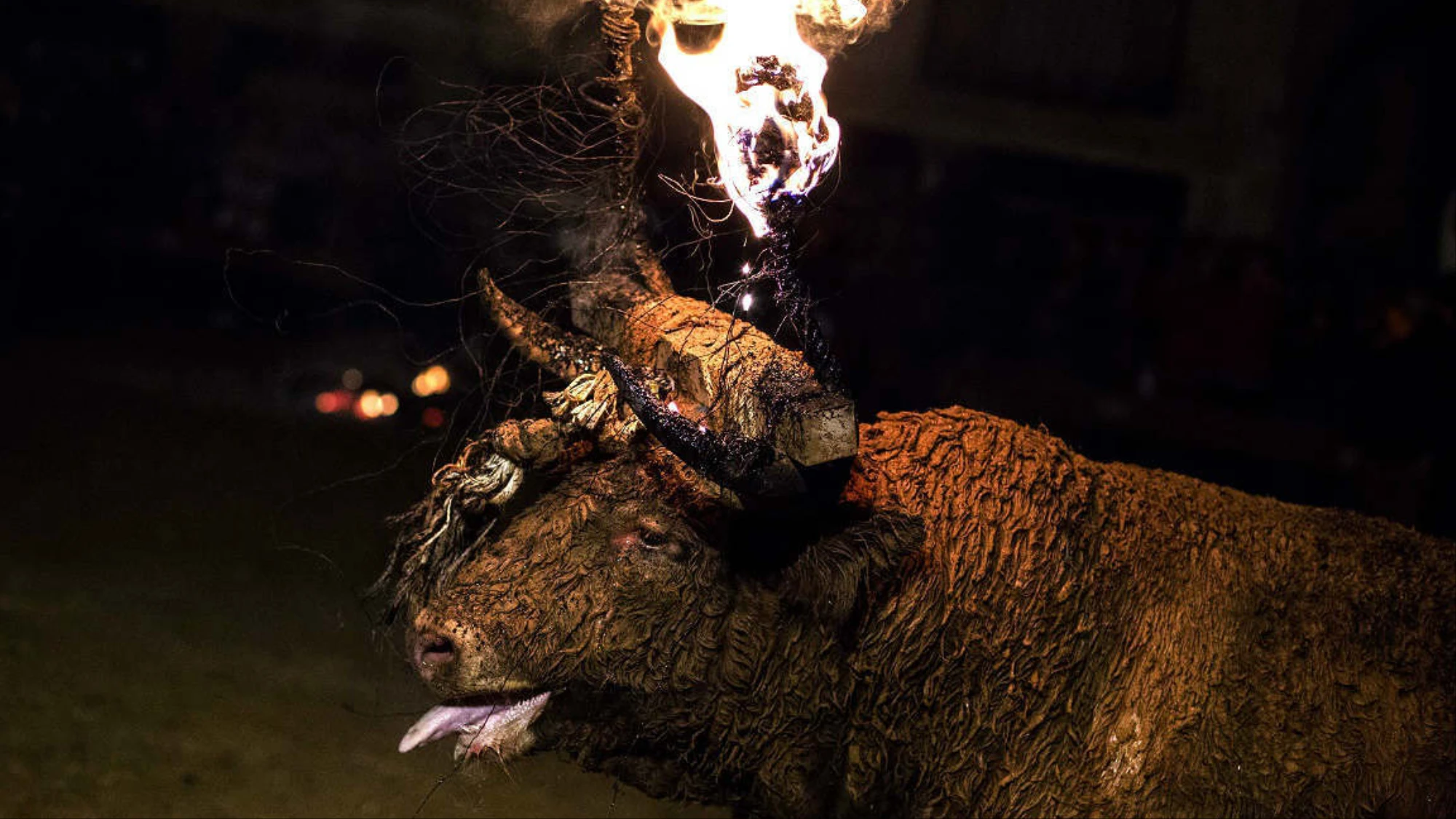What's this?
Fire Bulls
This show consists of immobilizing the bull by its head tied with ropes against a wooden pylon. To direct the bull to the pylon when they leave the truck, box, or from the corrals, it is pulled by the other end of the rope using the brute force of those who make up the group of bullfighters. It is common for the bull to suffer falls and sudden head shakes at this moment since the team will stop them in its tracks using the rope that holds its head. It is also common for the bull to get tangled in the rope, leaving it immobilized by its legs or poorly positioned in front of the pylon, so the process is often complicated and ends up being even longer and more distressing.
Once immobilized, metal fittings are attached to the horns, at the ends of which are placed balls impregnated with a liquid or flammable substance, capable of keeping the fire burning for a long time of about 20 to 30 minutes. These balls are then lit and the rope that holds it is cut, so that the bull can move in the area delimited for it, usually in bullrings, portable arenas, or through fenced town streets.

Problem
Nearly 2,500 bulls are packed with fire each year in a large number of Spanish municipalities, all with the approval and subsidies of town halls, councils, and regional governments, even though this practice entails intense suffering for the bull, a victim of exhaustion, blows, falls, as well as disorientation, fear, and anguish.
“Immobilizing a bull by the head, placing balls impregnated with a flammable substance on its horns and lighting them, making the animal run and nod in despair is one of the cruelest forms of celebration that we could invent”, Aïda Gascón, director of AnimaNaturalis.
Reasons
The act of setting a bull on fire is to exhibit an animal that generally causes amazement and admiration due to its size, expression, and movements, incorporating fire as another element of showiness and emotion that contributes to making the activity a little more spectacular and entertaining. Sometimes, in addition to fire, pyrotechnic sources are placed on their horns, which for several seconds expel sparks of fire up to several meters high. Fire bulls also serve as an exhibition of the participants' own skills and to demonstrate their bravery.
Consequences
The damage caused by hitting a bull can put the lives of these animals at risk, in addition to causing physical and psychological injuries. A large number of these animals are directly sent to the slaughterhouse that same night, since it is common that bullfighting clubs, instead of renting the specimen for the show and then returning it to the ranch, buy untamed or wild bulls, specimens that have never been taken out of the field. Sometimes cows are also bagged.
- Risk of death: Deaths generally occur as a result of brutal blows that the bulls themselves can inflict against stone walls, trees, metal fences, or other elements of street furniture when desperately trying to get rid of the fireballs that are attached to their head. They can also die from heart attacks due to stress or exhaustion.
- Breaks and injuries: In the process of the spectacle, cervical dislocations can occur during the struggle when they are being immobilized, or strong falls when they are pushed out of the truck or box and the rope stops them violently. They can suffer all kinds of injuries and breaks during the rest of the celebration since it is common for the bull to be encouraged to go up, down, and jump over obstacles, or to crash into the fences that serve as protection for the spectators. Bulls that have suffered damage that prevents them from being rented out again for other festivities are sent to the slaughterhouse.
- Burns: Burns on the bull's head, eyes, and back if a spark from the fire that is on its antlers jumps out.
- Psychological suffering: Although it may seem that bulls are strong and brave animals, the truth is that they are rather ruminant bovines, especially excitable, temperamental and nervous, and show feelings of panic if they are separated from their social group. If we add to this the anguish of feeling trapped inside a truck or crate, immobilized by dozens of men who hold him by the whole body, the noise of the screams, the pyrotechnics, music or applause, and the natural fear of fire that any animal has, we can say that undoubtedly the practice of putting fire on a bull brings him a great psychological suffering.
